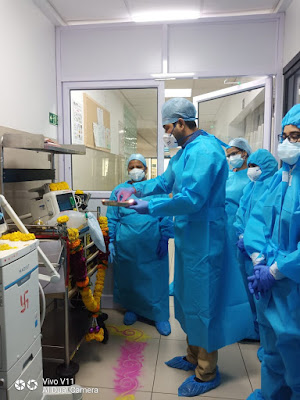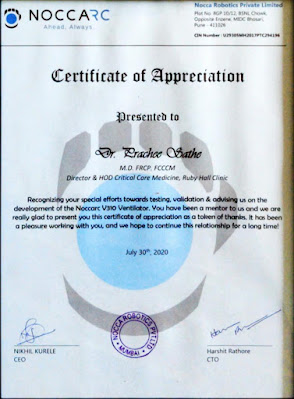Artificial Ventilation: Science and Myths
In dire need of the truth to be told about life-saving machines
Dr. Prachee sathe M.D., FRCP, FCCCM
Director, ICU, Ruby Hall Clinic, Pune, India
HISTORY
 |
| Hospital staff are examining a patient in a tank respirator, iron lung, during the Rhode Island polio epidemic. The iron lung encased the thoracic cavity externally in an air-tight chamber. The chamber was used to create a negative pressure around the thoracic cavity, thereby causing air to rush into the lungs to equalize intrapulmonary pressure. (1960) source : CDC |
History is proof to the fact that major healthcare emergencies can call for creative solutions and that these can often be unorthodox. Take for example, the 1952 Copenhagen polio epidemic where over 300 patients developed respiratory paralysis within a short span of a few weeks with infectious hospitals being completely overwhelmed. Desperate times called for desperate measures. Relays of medical students manually ventilated the lungs of patients using rubber bags attached to tracheostomies under the guidance of the anaesthetist.
In another case, in Beijing in 2003, trainees from unrelated specialties found themselves managing a sealed intensive therapy unit filled with avian flu victims, while receiving clinical guidance from overseas experts via a mobile phone.
Introduction
 |
| Modern day ventilator, a life saver |
For someone who is drowning in the furious sea, a small boat can probably save his life. But this can be true only till the sea storm settles or the victim reaches a safe land. The boat will not settle the sea storm, but will probably provide enough support to save a person from a catastrophe. In reality, the ventilator can be compared to the small boat. Contrarily, artificial ventilation has been misunderstood over the years despite saving lives owing to wrong projections and misguided perceptions. There is a substantial misunderstanding about the complexities of intensive care treatments, especially life support interventions.
At a time when the world is facing one of the most heart wrenching medical emergencies in the form of the novel coronavirus, the use of the ventilator has emerged to be the most successful method to save a dying life. In addition to lockdowns, curfews and economic upheaval, living-room discussions are revolving around the shortage of ventilators world over. Every country across the globe is busy assessing the available stock of working ventilators — much like assessing military equipment before starting a war.
With a population of 1.3 billion people, India has about 40,000 working ventilators in the private and public sector. According to global trends, about one in six people with Covid-19 gets seriously ill, which can include breathing difficulties. The country faces seeing its hospitals hobbled as others around the world have been, with doctors forced to choose who they try to save. The race to develop an inexpensive, home-grown invasive breathing machine seems to have begun and the government needs to be applauded for encouraging this initiative.
What is a ventilator?
Is it a life saver? Is it a ‘money churning machine’ as mentioned by interlocutor and host Aamir Khan in Satyameva Jayate years ago? Or is it a machine for prolonging the meaningless and futile existence of human life? A ventilator is a hospital bedside machine that assists with two critical functions: getting enough oxygen into the bloodstream and clearing out carbon dioxide, which can build up when the patient is too weak or sick to move air in and out of the lungs. This allows the patient who has a respiratory condition to receive the proper amount of oxygen by creating a positive pressure. It also helps the patient’s body to heal, since it eliminates the extra energy of laboured breathing.
As intensivists, we use artificial ventilators as powerful tools and vital allies to manage patients with respiratory distress. The truth is that ventilators are not a cure or treatment by themselves. They merely act as a support system to buy time while the physiological aspects of the body can be medically managed, giving a patient’s lungs the much required time they need to heal by themselves. Having said this, there is much ambiguity about these life-saving machines and in times such as these, it’s perhaps best to clear the air about it.
 |
| Multiple machines in ICU for treatment of organ failure |
What are some myths and facts related to the ventilator?
Myth: Once a patient is on the ventilator, he/she will not survive
Fact: When the human body is severely diseased or under stress, the lungs and heart need maximum support. This is a time when physiological processes in the body are very complex, fine-tuned and closely controlled. Herein, artificial ventilation comes into play. The fact is that when patients are provided support in the form of a ventilator, 75%-85% of them survive and go on to lead meaningful healthy lives even after prolonged ventilation.
Myth: Ventilators merely prolong a dying patient’s life
Fact: The truth is that every disease has a reversible and irreversible state. There is always a window of reversibility in any disease. This depends on the combined application of the experience of the intensivist and the ability of the machine help the patient recover in the long run, if the ventilator is used within optimum time.
Myth: Doctors use ventilators as per their will
Fact: There are certain scientific parameters that are crucial factors to utilising a ventilator for a patient hanging between life and death. This decision is always taken in conjunction with the will of the family and scientific factors.
 |
| Monitoring of health parameters of patients in ICU |
Myth: Once a patient is on the ventilator, the doctor has no specific role
Fact: A large number of medical workers are required when a patient is put on the ventilator. The patient is constantly manned by an army of people including senior intensivits, resident doctors, and medical consultants who work round-the-clock. Right from what percentage of oxygen needs to be delivered, how may breaths per minute, how to remove carbon dioxide from the body, how not to cause any damage to the patient’s lungs - they find solutions to all these medical issues. 
Nurses too play an important role of supporting the patient and the family psychologically. Lab technicians and diagnostic imaging specialists too play their part in the everyday happenings. A team of physiotherapists ensure the muscles of patients don’t disfunction when he/she is weaned off it, while support staff take care of all the bedside needs of the patient including personal hygiene as well as changing the position of a patient.
Myth: Being on ventilation equals to putting your life at risk.
Fact: The main risk of ventilation is an infection, as the artificial airway (breathing tube) may allow germs to enter the lung. When positive pressure ventilation is used as against the natural negative pressure ventilation, it is bound to have some side effects on the patient’s physiology. It transmits pressure on the heart making it function against resistance. In some cases, it may cause a drop in blood pressure and may cause heart to work even harder. In some cases, it could also increase blood pressure inside the lungs. However, that’s what we as intensivists work round-the-clock to prevent.
Myth: Once on ventilator, the hospital will keep the patient on it for a long time
Fact:
The main purpose of a ventilator is to allow the patient time to heal.
Usually, as soon as a patient can breathe effectively on their own, he/she is taken off the ventilator. Doctors perform a series of tests to check the patient's ability to breathe on their own. The healthcare firmament today is fighting one of its biggest battles of modern times, the roots of which seem to run far and wide across the length and breadth of the world. As doctors, and as part of our emergency management planning, we’re all exploring how we can do things which would not be our typical care. But in atypical times, we need to come up with creative and innovative solutions to do what we do best — save lives.














